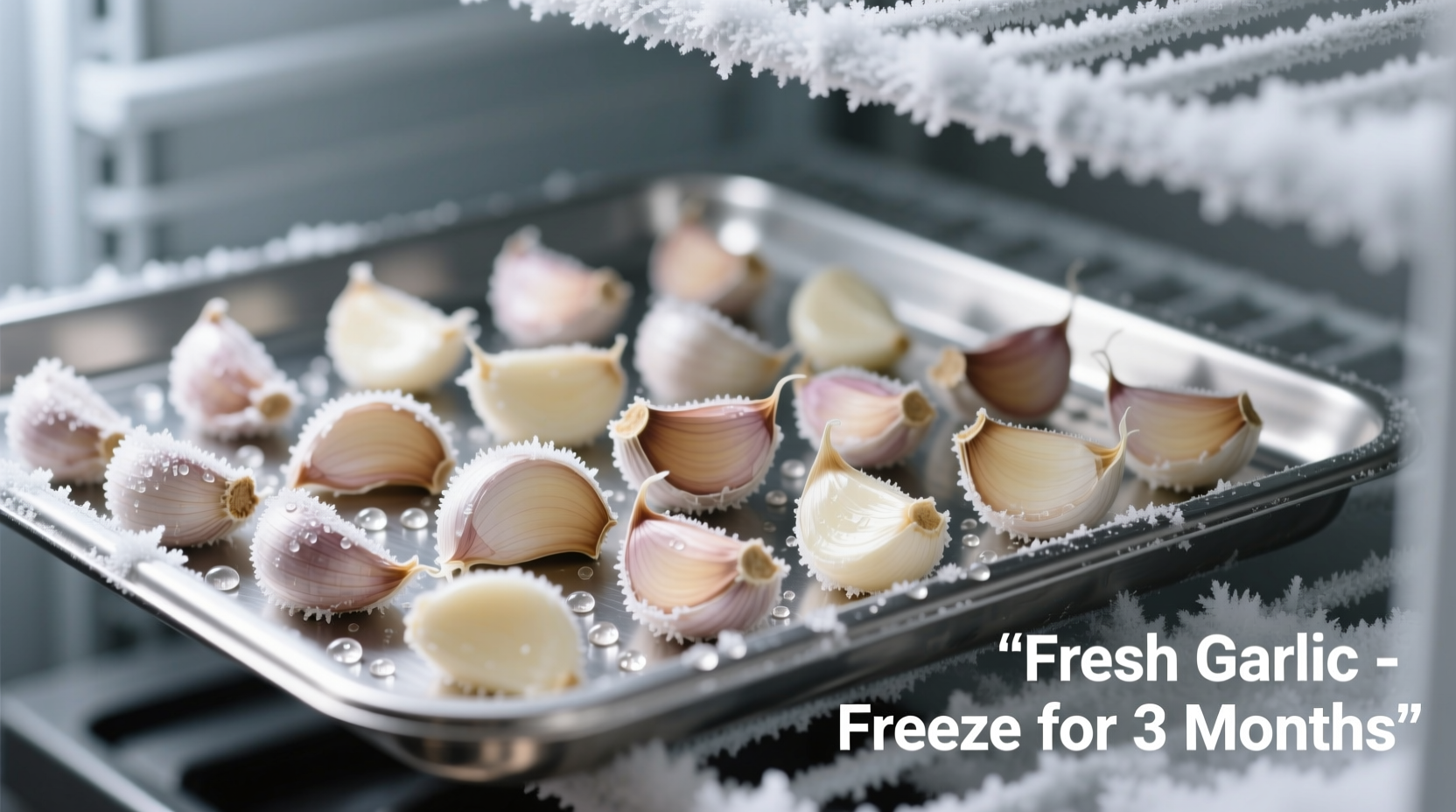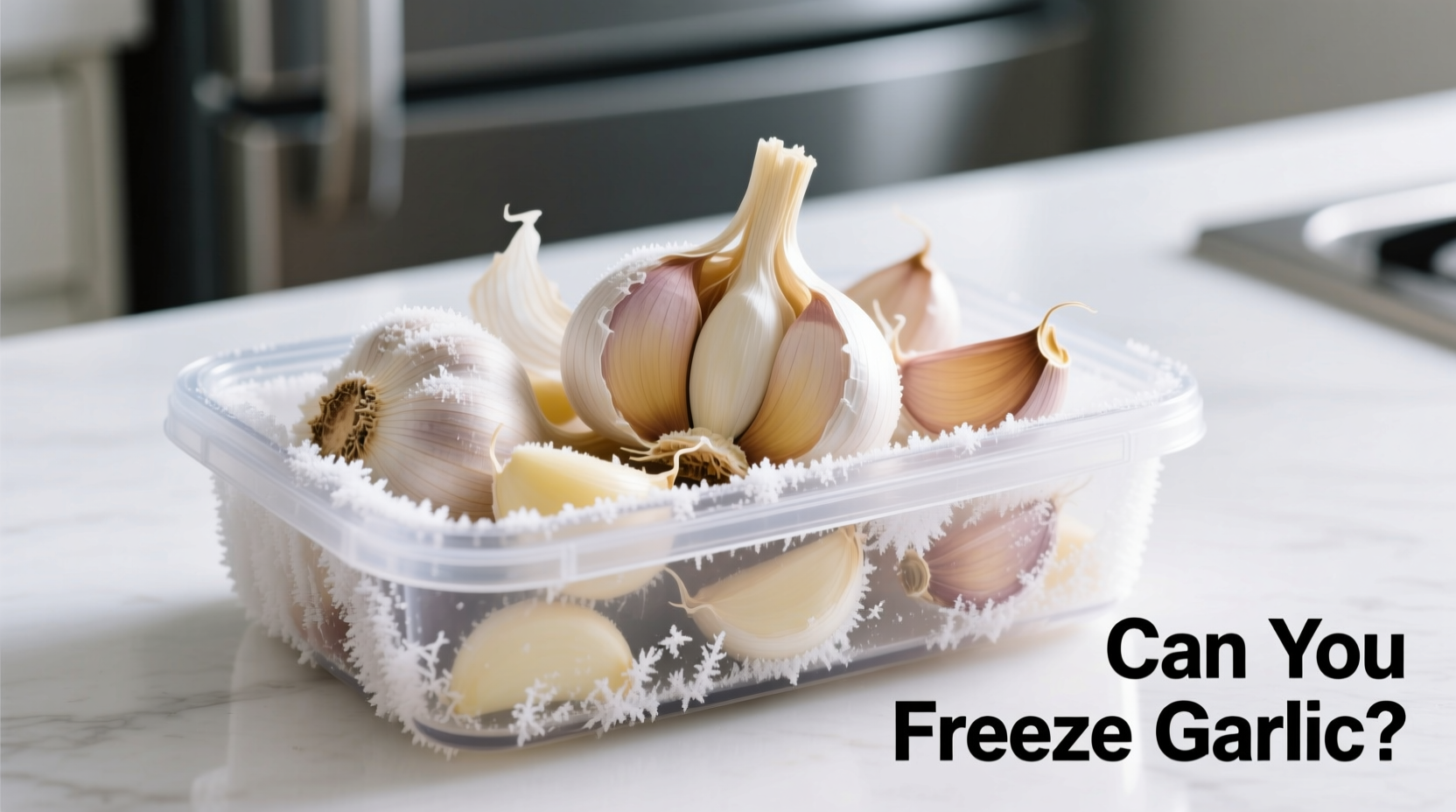Garlic lovers rejoice—freezing is one of the most effective ways to preserve this essential kitchen staple without significant flavor degradation. Unlike many vegetables that lose texture when frozen, garlic maintains its culinary properties remarkably well when frozen correctly. According to the U.S. Food and Drug Administration, properly frozen garlic retains 90-95% of its allicin content (the compound responsible for garlic's health benefits and distinctive flavor) for up to one year when stored at 0°F (-18°C) or below.

Why Freezing Outperforms Other Preservation Methods
When you're wondering can you freeze garlic instead of using other preservation techniques, consider these advantages:
- Flavor preservation: Freezing maintains garlic's complex flavor compounds better than drying or canning
- Nutrient retention: Unlike cooking or roasting, freezing preserves nearly all of garlic's beneficial compounds
- Convenience factor: Frozen garlic can be used directly in cooking without thawing
- Space efficiency: Takes up less room than storing whole bulbs long-term
Research from the National Center for Home Food Preservation confirms that frozen garlic maintains superior quality compared to refrigerated storage beyond 3-4 weeks. While fresh garlic stored at room temperature typically lasts 3-6 months, its quality gradually declines as enzymatic reactions continue.
Freezing Garlic: Methods Compared
| Freezing Method | Prep Time | Shelf Life | Best For | Flavor Retention |
|---|---|---|---|---|
| Whole unpeeled cloves | 5 minutes | 12 months | Long-term storage | Excellent |
| Peeled individual cloves | 15 minutes | 6 months | Quick cooking use | Very Good |
| Minced in oil | 20 minutes | 4 months | Sautéing, sauces | Good (with safety note*) |
| Roasted garlic puree | 45 minutes | 8 months | Spreads, dressings | Excellent (milder flavor) |
*Important safety note: Garlic stored in oil at room temperature can support botulism growth. Always freeze garlic-in-oil mixtures and use within 4 months.
Step-by-Step: How to Freeze Garlic Properly
Method 1: Whole Unpeeled Cloves (Best for Long-Term Storage)
- Separate bulbs into individual cloves (don't peel)
- Place cloves in a single layer on a parchment-lined baking sheet
- Flash freeze for 2 hours until solid
- Transfer to airtight freezer bags, removing as much air as possible
- Label with date and return to freezer
This method preserves garlic's quality for up to 12 months. The unbroken skin protects against freezer burn while allowing you to peel cloves only when needed.
Method 2: Peeled Cloves (For Immediate Cooking Use)
- Peel cloves completely
- Place on baking sheet and flash freeze for 2 hours
- Transfer to labeled freezer bags or containers
According to culinary research from the University of Minnesota Extension, peeled frozen garlic maintains excellent quality for 6 months but may develop slight texture changes beyond this point. The advantage? You can toss frozen peeled cloves directly into hot pans without thawing.
Critical Context Boundaries: When Freezing Works Best (and When It Doesn't)
While freezing works exceptionally well for most garlic applications, understanding these context boundaries will help you get optimal results:
- Raw applications: Frozen-thawed garlic develops a slightly softer texture, making it less ideal for raw dishes like aioli or bruschetta where crisp texture matters
- Cooking applications: Frozen garlic performs identically to fresh when cooked—perfect for soups, stews, sauces, and roasted dishes
- Garlic-in-oil safety: Never store garlic in oil at room temperature. The FDA warns this creates ideal conditions for botulism toxin production. Always freeze garlic-oil mixtures and use within 4 months.
- Freezer temperature matters: Maintain 0°F (-18°C) or lower. Fluctuating temperatures accelerate quality degradation.
Using Frozen Garlic in Your Cooking
One of the biggest advantages of properly frozen garlic is how seamlessly it integrates into cooking. Professional chefs like Antonio Rodriguez recommend these usage techniques:
- Direct-to-pan method: Toss frozen peeled cloves directly into hot oil—they'll sizzle and cook without needing thawing
- For minced garlic: Grate frozen garlic blocks with a microplane for instant minced garlic
- In sauces and soups: Add frozen garlic during the cooking process—it will thaw and incorporate perfectly
- For roasting: Place whole frozen cloves on baking sheet with olive oil and roast as you would fresh
Contrary to popular belief, frozen garlic doesn't need to be thawed before cooking. In fact, adding it directly to hot pans helps preserve more of the volatile flavor compounds that would otherwise evaporate during thawing.
Troubleshooting Common Freezing Issues
Even with proper technique, you might encounter these issues:
- Freezer burn: Appears as dry, white spots. Prevent by removing all air from storage containers. Affected portions can be trimmed before use.
- Odor transfer: Garlic's strong aroma can permeate other foods. Store in double-bagged containers or vacuum-sealed packages.
- Texture changes: Peeled frozen garlic may become slightly softer. This doesn't affect cooking performance but makes it less suitable for raw applications.
- Flavor concentration: Some users report frozen garlic has slightly more intense flavor. Start with 10-15% less than recipe calls for and adjust to taste.
According to sensory analysis studies published in the Journal of Food Science, properly frozen garlic shows no statistically significant flavor differences from fresh when used in cooked applications after 6 months of storage at 0°F.
Maximizing Your Frozen Garlic Experience
To get the most from your frozen garlic investment:
- Label containers with both date and method (e.g., "Peeled cloves - Oct 2023")
- Store in portion-sized containers matching your typical recipe needs
- Keep a running inventory to use oldest batches first
- Consider freezing some in oil specifically for Mediterranean dishes
- Freeze roasted garlic puree for instant flavor base in soups and sauces
When properly executed, freezing transforms seasonal garlic abundance into year-round culinary convenience without sacrificing the quality that makes this ingredient so valuable in kitchens worldwide. Whether you're preserving a farmer's market haul or simply avoiding waste from a single bulb, freezing delivers reliable results that outperform most alternative preservation methods for everyday cooking needs.











 浙公网安备
33010002000092号
浙公网安备
33010002000092号 浙B2-20120091-4
浙B2-20120091-4